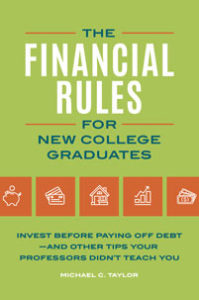
On Teaching Compound Interest and Discounted Cash Flows
“The most powerful force in the universe is compound interest”
– Albert Einstein[1]
“Tomorrow and tomorrow and tomorrow,
Creeps in this petty pace from day to day
To the last syllable of recorded time”
This Spring I began teaching Personal Finance to a group of bright college students, and we recently wrapped up a section on compound interest and discounted cash flows.
What I’m trying to get across to these undergraduates is that all of the key financial choices they will make in their lives – all of their future decisions about consumer debt, retirement, insurance, purchasing a home, tax preparation, and investing – will be much, much better decisions if they deeply understand compound interest and discounted cash flows.
What are these concepts for?
The compound interest formula tells these students, and any of us who use it, exactly how quickly, and to what ultimate size, money grows in the future.[2]
Discounted cash flows reverses the process, and tells us what the present value would be of any given cash flow or series of cash flows that occurs in the future.[3]
I’ve realized over the course of the last few weeks, however, that I’m trying to convince these students of the absolute centrality of an idea that 95% of them have never heard of before walking into my class.
Not only this, but also 95% of the people my students will meet in their life never have heard of compound interest and discounted cash flows, and therefore will not have the slightest idea how profoundly it affects their lives and their personal financial choices.
Picture me in front of the class jumping up and down and waving my arms wildly (metaphorically of course), trying to get them to believe me.
And yet, why should they believe me when I appear to be the first (and possibly insane) person to ever argue this case?
I’m afraid that after they leave my class, the Financial Infotainment Industrial Complex will never again reveal the importance of compound interest and discounted cash flows to personal finance decision-making.
Why isn’t this taught as a requirement of Junior High School Math?
I was a strong math student in junior high and high school.[4] I received a solid foundation in algebra, geometry, trigonometry, and calculus. Of these, algebra has frequently proved useful, but none of the others apply to my life or career.
Compound interest and discounted cash flows, however, dominated my professional life as a bond salesman and hedge fund investor, and I make use of insights from them in my personal financial life all the time.
And yet, nobody taught me compound interest or discounted cash flows in school. I’d be willing to bet that almost all of you reading this didn’t get taught these concepts in school. That knowledge had to wait until I started as a bond guy at Goldman. This, despite the fact that you only need junior high school level math – basically algebra and the concept of ‘X raised to the power of Y’ – to understand and use compound interest and discounted cash flows.
The fact that school taught, and I spent years learning, complex but ultimately very niche mathematical skills, combined with the fact that nobody taught the essential mathematical skills of personal finance (and Wall Street finance for that matter) really gets up my nose when I think about it.
More than gets up my nose, it puts me in a suspicious frame of mind.
Why would these essential skills not be taught to every junior high school student, and then re-taught to every high school student, and then elaborated on for every college student? Because that’s how important this stuff is. And how relatively unimportant trigonometry, geometry and calculus skills are for most citizens.
I’ve only come up with a couple of possible explanations, as I explain below, but please chime in with your own theories.
1. Math teachers, as a group, do not understand the role of compound interest and discounted cash flows in personal finance.
I fear this is true. I’ve become friends with a few of my high school math teachers as an adult and with one I’ve discussed the power of compound interest as a math concept and as a personal finance concept. Later in his career, long after I took his class, he taught compound interest as part of his lessons on mathematics skills known as ‘sequences and series.’
In these later days he emphasized to his students that if he had really understood compound interest – as a young man – as well as he does now, his working and his retirement years would look totally different. Could somebody please tell the Professional Math Teachers Association (or whoever is responsible for this stuff) that this is really the key concept, and I mean, for everything?
2. The Financial Infotainment Industrial Complex wants to keep us down. I’m afraid I’m coming around more and more to this explanation. Nothing else makes sense.
I mean, seriously folks, calculus: Not relevant (for most people.) Compound interest: relevant (for everyone.)
Coming up next: Part II – Compound interest and Wealth
Part III – Compound interest and Consumer Debt
Part IV – Discounted Cash Flows Formula
Part V – Discounted Cash Flows – another example, using annuities
Part VI – Conclusion, and why we need this math as a society
——Addendum by Michael to this post:
One of my high school math teachers (and my high school advisor!) responded to my post by pointing out that not only does he teach compound interest, but that its part of the math textbook he wrote. How about that? I can’t resist linking to his textbook on Amazon, as my way of atoning for casting aspersions on math teachers.


[1] Albert Einstein frequently gets credited with this wise statement. A quick interwebs search suggests Einstein didn’t necessarily say this, as the first mention in print is found circa 1983. But Einstein could have, and should have, because it’s true.
[3] A nice place to start on discounted cash flows is Salman Khan’s video on present value #4 (and discounted cash flow). Khan doesn’t go far enough on discounted cash flows, or as far as I’m going to go in this series of blog posts to follow, but he at least gets us started, which is more than I can say for almost anyone else available for free out there.
[4] I didn’t pursue math in college, beyond one statistics class required for my concentration, which was Social Studies. Shout out to the 0.0005% of readers (I chose an arbitrary but statistically insignificant number) who will recognize my major and salute me for it, rather than assume I spent my college years doing what the rest of you did in Social Studies in middle school – memorizing state mascots.
Post read (33133) times.
 Welcome! This post is meant to accompany Chapter 5 and Appendix to Chapter 5 “On Discounting Cashflows” in my book “The Financial Rules For New College Graduates – Invest Before Paying Off Debt And Other Tips Your Professors Did Not Teach You.” (Praeger, April 2018.)
Welcome! This post is meant to accompany Chapter 5 and Appendix to Chapter 5 “On Discounting Cashflows” in my book “The Financial Rules For New College Graduates – Invest Before Paying Off Debt And Other Tips Your Professors Did Not Teach You.” (Praeger, April 2018.)



